Introduction
Global Capability Centers benefits have become a cornerstone of enterprise success in the digital era. These centers integrate strategy, technology, and talent into a unified model that allows organizations to achieve efficiency, scalability, and innovation simultaneously. Once limited to back-office operations, GCCs have now evolved into strategic innovation hubs driving transformation across industries.
Modern GCCs serve as global extensions of corporate headquarters, streamlining decision-making, ensuring governance, and enabling continuous improvement. They deliver business agility by centralizing expertise while maintaining local adaptability. As organizations scale, these centers play a critical role in operational excellence, digital transformation, and innovation velocity.
The Strategic Purpose and Evolution of GCCs
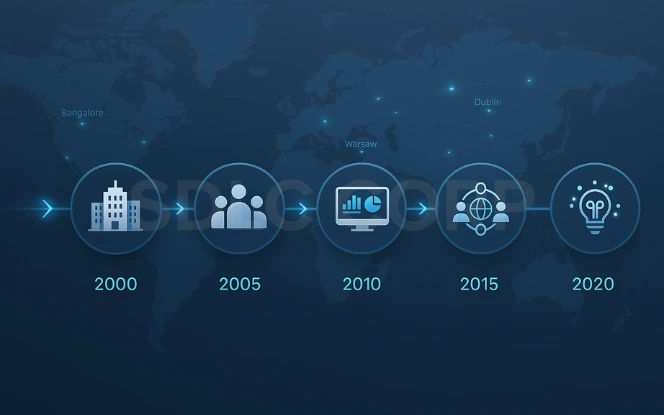
Global Capability Centers were originally established to consolidate business operations and reduce costs through shared services. Over time, they have evolved into global enablers that support innovation, analytics, automation, and enterprise-wide transformation.
In the early stages, GCCs were primarily focused on process optimization and offshore support. However, with the rise of cloud computing, AI, and data analytics, they now act as innovation laboratories that shape strategic direction. They combine governance, compliance, and operational performance under one integrated structure.
Leading enterprises like IBM, Accenture, and Microsoft use GCCs to develop advanced digital products, manage cybersecurity, and optimize global operations. These centers enhance consistency and ensure that technology aligns with corporate goals.
Modern GCCs function as command centers for managing technology delivery, R&D, finance, and human resources. They allow organizations to retain intellectual property and ensure compliance across borders while fostering continuous innovation.
To learn more about their journey from support to strategy, visit what is GCC? which explains how Global Capability Centers evolved into integral parts of enterprise success.
Key Benefits of Global Capability Centers
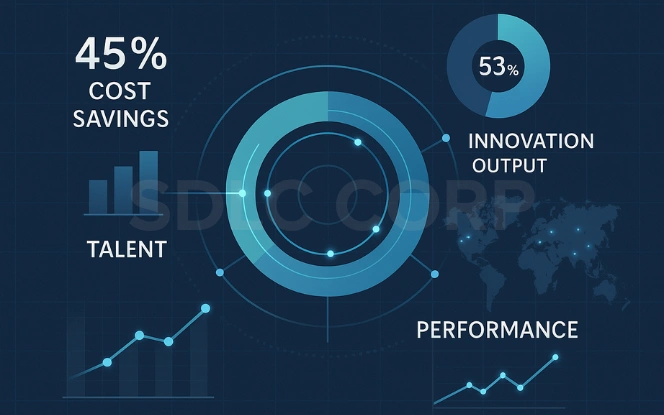
The Global Capability Centers benefits extend beyond operational efficiency. They create value across financial, human, and technological dimensions, allowing enterprises to stay competitive and adaptive.
Major advantages include:
- Cost optimization through centralized services and improved resource allocation.
- Talent access that builds a skilled workforce in analytics, engineering, and digital transformation.
- Innovation culture that encourages experimentation with automation and AI.
- Operational transparency supported by centralized governance and measurable performance.
Organizations leveraging GCC models often achieve significant cost savings and faster time-to-market. The governance structures embedded in these centers ensure accountability, compliance, and agility in decision-making.
According to AI-first Global Capability Centers, enterprises using data-driven frameworks within GCCs report up to 40% higher efficiency and stronger cross-department collaboration. This integration supports scalability while maintaining global consistency.
Strategic Impact on Enterprise Growth
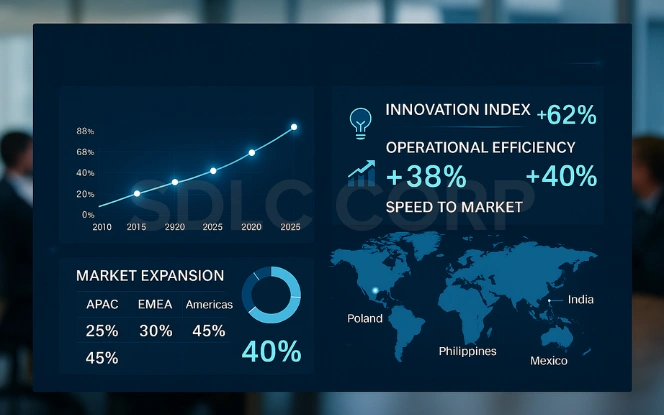
A robust Global Capability Center strategy directly influences enterprise growth by aligning digital capabilities with corporate goals. GCCs serve as the bridge between global leadership and local execution, driving unified strategies across departments and geographies.
These centers enable companies to scale operations while maintaining control, quality, and flexibility. They consolidate key business processes including finance, IT, analytics, and procurement into unified structures that reduce complexity.
Strategic impacts include:
- Streamlined execution through centralized management.
- Enhanced agility with data-backed decision systems.
- Faster innovation cycles using integrated tools.
- Improved governance through transparent KPIs.
Enterprises building high-performance GCCs in the UAE demonstrate how strategic integration of AI and analytics within GCCs results in measurable productivity gains and lower operational costs.
In addition, GCCs foster leadership development by empowering internal teams to manage complex operations independently. This autonomy supports global expansion and continuous innovation while reducing reliance on third-party vendors.
The Role of Technology in Strengthening GCCs

Technology is the cornerstone of every high-performing GCC. Through digital transformation via global capability centers, companies integrate advanced tools that drive accuracy, scalability, and intelligence across their operations.
Core technologies driving GCC performance include:
- Artificial Intelligence (AI) for analytics, predictive maintenance, and automation.
- Robotic Process Automation (RPA) for improving speed and reducing human error.
- Cloud platforms for seamless collaboration and accessibility.
- Cybersecurity frameworks that ensure compliance and data protection.
Digital maturity allows GCCs to become innovation catalysts that enhance enterprise agility. By applying machine learning and data science frameworks, GCCs can detect trends, manage risks, and optimize global operations in real time.
The development of Global Capability Centers in the UK demonstrates how automation and AI integration lead to higher operational resilience and faster delivery timelines.
Technology-driven GCCs not only enhance efficiency but also support sustainable growth through intelligent, data-backed operations.
Operational Benefits: Efficiency, Scalability, and Agility
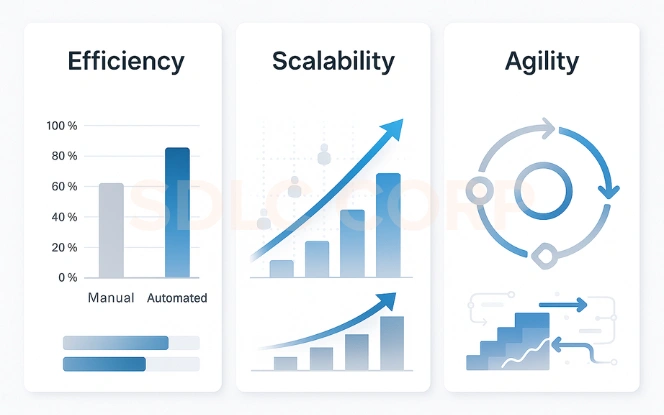
Operational excellence defines the impact of global capability centers. They streamline workflows, enhance service delivery, and ensure that enterprises can respond quickly to market changes without sacrificing quality.
Operational advantages include:
- Real-time analytics and monitoring for better visibility.
- Unified reporting systems that improve coordination.
- Agile methods enabling quicker project execution.
- Consistent service delivery across global locations.
High-performance GCCs in the US illustrate how centralized operations and strong governance models create a foundation for scalable, predictable performance.
Additionally, GCCs enhance business resilience during global disruptions. Centralized systems allow remote continuity and cross-border collaboration without operational downtime. This flexibility ensures enterprises remain productive regardless of market conditions.
By fostering agility, GCCs become vital for driving efficiency, reducing redundancy, and achieving faster go-to-market execution in competitive industries.
Economic and Organizational Impact of GCCs
GCCs play a pivotal role in both enterprise transformation and regional economic development. They generate employment, transfer knowledge, and foster innovation ecosystems.
Economic impacts:
- Creation of specialized jobs in technology, analytics, and research.
- Attraction of global investment and infrastructure development.
- Acceleration of innovation-driven growth within host countries.
Organizational impacts:
- Strengthened IP protection and data control.
- Enhanced transparency through governance models.
- Development of a global, collaborative workforce culture.
As outlined in how much it costs to set up a GCC, the long-term return on investment outweighs initial setup expenses. These centers drive measurable performance, improve brand reputation, and support sustainable business practices.
By merging local expertise with global strategy, GCCs become both economic contributors and strategic differentiators in competitive industries.
Long-Term Business Benefits: Innovation and Value Creation
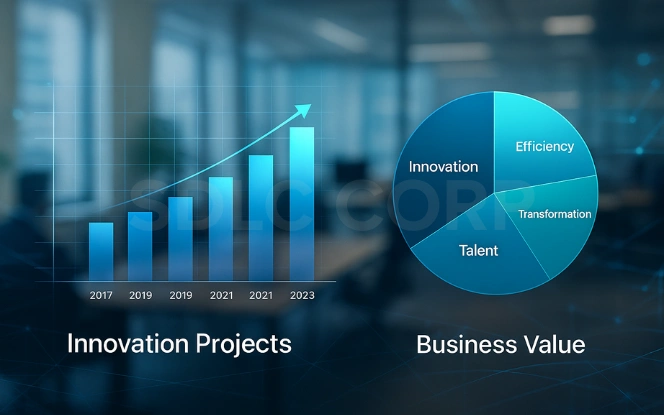
The long-term Global Capability Centers benefits extend beyond operational efficiency. They redefine enterprise innovation and growth models. GCCs continuously adapt to market needs through data-driven insights, automation, and ecosystem partnerships.
Long-term benefits include:
- Enhanced product innovation through integrated R&D.
- Continuous improvement using AI analytics and automation.
- ESG-aligned growth through sustainability initiatives.
- Knowledge-sharing that accelerates digital maturity.
These centers serve as innovation engines, connecting global business units through shared technologies and collaborative culture. They also help enterprises manage large-scale transformations while maintaining agility.
Strategic partnerships with universities, tech startups, and local governments further boost their value-creation capabilities. This ecosystem-based model positions GCCs as sustainable growth enablers for the next generation of digital enterprises.
Challenges and the Future of Global Capability Centers
Despite remarkable success, GCCs face challenges related to scalability, talent management, and evolving digital expectations. Addressing these effectively is crucial for long-term relevance.
Key challenges include:
- Retaining skilled professionals amid global competition.
- Managing compliance across diverse regulatory landscapes.
- Integrating sustainable practices into operations.
- Maintaining innovation speed while ensuring security.
Future GCCs will rely heavily on automation, AI, and predictive analytics to overcome these challenges. The high-performance GCC framework in the UAE showcases how digital governance and hybrid work models enhance adaptability and resilience.
In the coming years, GCCs will evolve into intelligent, automated ecosystems that merge human insight with digital capabilities. Their success will depend on balancing efficiency with innovation while maintaining ethical and sustainable growth.
Case Study: GCC Innovation in Action
A global technology enterprise established its GCC in India to handle IT support and data management. Within three years, the center evolved into a digital innovation hub supporting automation, AI research, and process analytics.
Key achievements:
- 35% cost reduction through automation and process optimization.
- 45% faster project delivery timelines.
- 25% increase in customer satisfaction rates.
- Proprietary AI frameworks scaled across global business units.
By combining process re-engineering, analytics, and agile frameworks, the organization transformed its GCC into a source of innovation and strategic value.
This transformation highlights how a well-executed Global Capability Center strategy can deliver measurable outcomes that enhance productivity, resilience, and digital competitiveness across global markets.
Conclusion
The Benefits and Impact of Global Capability Centers go far beyond operational gains. These centers deliver Global Capability Center cost efficiency, leverage talent pools in global capability centers, and promote digital transformation via global capability centers, ensuring enterprises remain innovative and resilient.
By combining technology, process discipline, and strategic insight, GCCs have become key enablers of digital-first enterprises. Their ability to drive continuous innovation, improve scalability, and strengthen governance makes them a core pillar of global business success.
Enterprises that invest in a well-defined Global Capability Center strategy are better positioned to navigate market shifts, achieve sustainable growth, and lead transformation at scale.
For guidance on setting up or optimizing your GCC, Contact us SDLC Corp.
FAQs
What Are the Main Benefits of Global Capability Centers?
The main Global Capability Centers benefits include cost efficiency, faster innovation, and improved talent utilization. These centers help organizations centralize their global operations, improve governance, and enhance agility. They also serve as strategic hubs for research, technology development, and digital transformation.
How Do Global Capability Centers Support Digital Transformation?
Digital transformation via global capability centers helps enterprises adopt automation, cloud technology, and data analytics. By centralizing expertise and digital infrastructure, GCCs reduce manual processes and improve real-time decision-making, enabling faster innovation and smarter resource utilization.
Why Are Global Capability Centers Essential for Cost Efficiency?
Global Capability Center cost efficiency comes from process consolidation, automation, and shared infrastructure. By reducing duplicate functions and third-party dependencies, GCCs improve financial predictability and operational transparency while delivering long-term savings and productivity gains.
How Do Global Capability Centers Build Skilled Talent Pools?
Talent pools in global capability centers give companies access to specialized professionals in engineering, analytics, and automation. These centers attract global talent while offering training and career development programs that align with business goals, helping enterprises maintain a future-ready workforce.
What Is the Long-Term Impact of Global Capability Centers on Businesses?
The impact of global capability centers goes beyond cost savings. GCCs enhance innovation, business resilience, and digital agility. As organizations adopt AI and automation, these centers evolve into strategic hubs that lead transformation, improve global competitiveness, and create sustainable value.



















